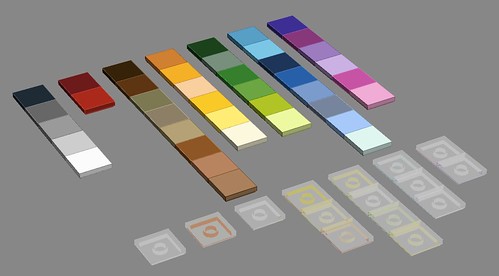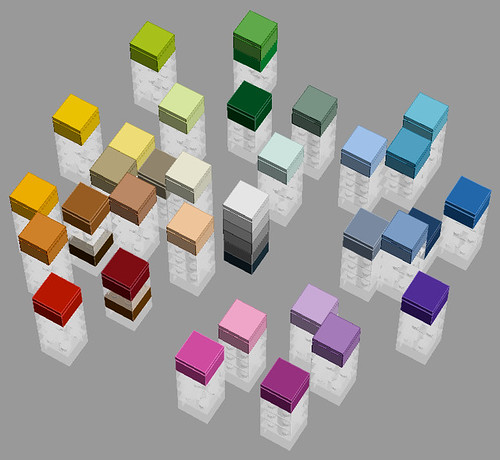I want to write a few blog posts about LEGO colors, and thought I should brush up on the LEGO color palette. Seems like a simple question, right, "what colors does LEGO come in?"
Oh my.
Just for starters, that seemingly simple question breaks down into sub-questions such as:
- What kind of colors do you mean? There are solid colors, transparent colors, metallic colors, but also colors of textile, string parts, and decals
- What time period are you talking about? There are 30 or more solid colors that aren't in 2013 sets, and even defining "current" colors is a little tricky
- What LEGO systems are you talking about? A few colors appear only in Duplo, Modulex, Fabuland, or other systems
- Where are you using your colors? Lego Digital Designer has a more limited palette (though Extended Mode has more colors), or are you going on the market to buy older parts with other colors?
It seems bizarre at first to find that kind of complexity in just one attribute of LEGO. But it should be no surprise. LEGO has been making parts for decades, the product changes (e.g., the whole grey vs. bley debacle), and it's a big company with thousands of employees and millions of customers of all ages. There's no way all those people are going to agree, on any given day, on what the colors are or even what they're called.
After looking at all that, I decided to use what's in Lego Digital Designer (version 4.3) as my starting point. The palette in Extended Mode in LDD is basically the same (give or take a couple colors) as what Bricklink lists as colors current for 2013, without dwelling too much on historical colors I'm not likely to be buying.
Here are the 41 solid and 15 transparent colors in the LDD palette, roughly grouped together in the order they appear in LDD (click for color IDs and names):
Even this simple grouping contains a few interesting things:
- Where's that extra shade of grey coming from? Turns out it's a Light Stone Grey found in a few non-mainstream parts. Rats.
- Not much red, is there? Unless you count all those reddish browns. Turns out one good strong accent red is what you mostly need.
- Speaking of browns, there are quite a lot aren't there? Although we'll see later that most aren't widely used.
- In the rightmost column, we can really see the cool new magenta-oriented colors that have come up with Friends and other sets in the last few years.
If you're used to graphic design tools like Photoshop, the colors n the LDD color picker can seem a little jumbled. The official LEGO reference provides a little more structure, but not much. A couple of references such as Peeron provide RGB and CMYK values, so I tried making a CMYK color wheel:
In this view, Yellow is top left, Cyan is top right, and Magenta is to the bottom, with saturation decreasing toward white in the center. The height of each brick indicates Black; lower bricks have more Black. (Take this with a grain of salt -- I'm no graphing expert, plus I guessed for some colors without CMYK values.)
Ok, yeah, it's still kinda jumbled. But a few observations from this:
- Those Friends colors really fill out the palette! Without them, there would be a big gap on the Magenta side.
- Although there are only 41 individual colors, what we have now is is a pretty nice even distribution of colors. Of course, that's without regard to actual parts availability -- more on that below.
- Only a third of the colors are the highly saturated ones you see around the outside, that you associate with LEGO as a toy. The rest are toward the center -- less saturated, more naturalistic colors for making "real looking" stuff.
Ok great, now I'm a little more familiar with the palette. But I also know that some colors are much rarer than others. If I were designing something, let's say something big, what colors would I be likely to find the most parts in? Let's turn the LDD palette into a bar graph (click for color IDs and names):
This is based on BrickLink data on the number of types of part known to exist in each color. A color gets just a tile if it has <100 part types; plus a plate if it has up to 500, or two if it has up to 1,000; or one brick per 1,000 part types, rounded to the nearest 1,000. (Of course, you could do a similar graph based on the number of parts, or types of parts, available to buy, or their average cost. This graph is just one indication.)
In my collection, the most common colors are Light and Dark Stone Grey. (That's probably because I bought a lot of Star Wars.) But in general, if you were building something big, the graph suggests you'd consider White, Bright Red, Bright Yellow, and Black, with some Bright Blue accents. Sounds a lot like a traditional children's toy, doesn't it? Hmm.
Those "rare" and "new" colors have a lot of catching up to do, and for now we'll rightly treasure those unusual browns, magentas, and blues. Use them wisely!
Those "rare" and "new" colors have a lot of catching up to do, and for now we'll rightly treasure those unusual browns, magentas, and blues. Use them wisely!
In future blog posts, we'll get into individual colors and their uses, as well as some LEGO themes and their color schemes.
All the references used above, plus a few more:
- BrickLink Color Guide, listing colors links to parts and lots for sale
- Brickset Parts Browser, listing parts by color with links to sets
- Peeron Color List, cross-referencing Peeron, BrickLink, and LEGO color names and IDs
- Brickipedia Color Palette page, probably not totally up to date but a useful format
- Isodomus Color Tree Pages, including a Color Tree grouping of colors and a LEGO Color List including scanned LEGO tiles
- LEGO's own 2010 Color Palette (PDF), hosted by BrickJournal
- LEGO's own 2011 Color Palette on Eurobricks; that seems to be the last version released by LEGO
- An unofficial 2013 Color Palette by Joel Baker
- A handy LEGO color list that several people link to as having been obtained from LEGO at some point
- The LDD Reference thread on Eurobricks is a little old but contains information about colors in LDD



No comments:
Post a Comment
Thanks for your comment! To keep this blog useful, I reserve the right to remove comments that are off-topic or uncivil. Leg godt!